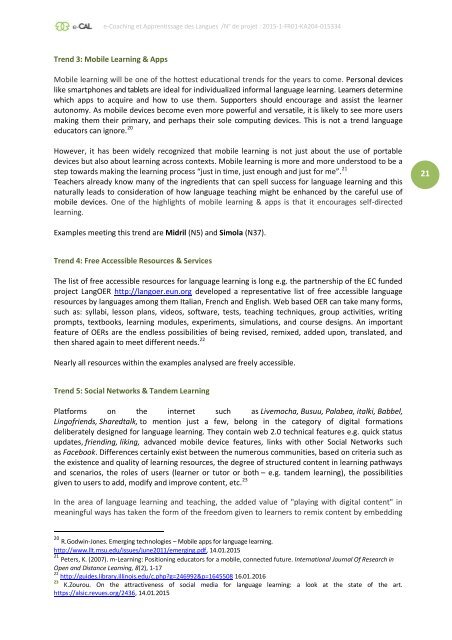e-CAL - e-Coaching et Apprentissage des Langues
The ERASMUS+ project e-CAL presents the result of an analysis of support methods in the case of language learning using web-based Open Educational Resources (OER).
The ERASMUS+ project e-CAL presents the result of an analysis of support methods in the case of language learning using web-based Open Educational Resources (OER).
You also want an ePaper? Increase the reach of your titles
YUMPU automatically turns print PDFs into web optimized ePapers that Google loves.
e-<strong>Coaching</strong> <strong>et</strong> <strong>Apprentissage</strong> <strong>des</strong> <strong>Langues</strong> /N° de proj<strong>et</strong> : 2015-1-FR01-KA204-015334<br />
Trend 3: Mobile Learning & Apps<br />
Mobile learning will be one of the hottest educational trends for the years to come. Personal devices<br />
like smartphones and tabl<strong>et</strong>s are ideal for individualized informal language learning. Learners d<strong>et</strong>ermine<br />
which apps to acquire and how to use them. Supporters should encourage and assist the learner<br />
autonomy. As mobile devices become even more powerful and versatile, it is likely to see more users<br />
making them their primary, and perhaps their sole computing devices. This is not a trend language<br />
educators can ignore. 20<br />
However, it has been widely recognized that mobile learning is not just about the use of portable<br />
devices but also about learning across contexts. Mobile learning is more and more understood to be a<br />
step towards making the learning process “just in time, just enough and just for me”. 21<br />
Teachers already know many of the ingredients that can spell success for language learning and this<br />
naturally leads to consideration of how language teaching might be enhanced by the careful use of<br />
mobile devices. One of the highlights of mobile learning & apps is that it encourages self-directed<br />
learning.<br />
21<br />
Examples me<strong>et</strong>ing this trend are Midril (N5) and Simola (N37).<br />
Trend 4: Free Accessible Resources & Services<br />
The list of free accessible resources for language learning is long e.g. the partnership of the EC funded<br />
project LangOER http://langoer.eun.org developed a representative list of free accessible language<br />
resources by languages among them Italian, French and English. Web based OER can take many forms,<br />
such as: syllabi, lesson plans, videos, software, tests, teaching techniques, group activities, writing<br />
prompts, textbooks, learning modules, experiments, simulations, and course <strong>des</strong>igns. An important<br />
feature of OERs are the endless possibilities of being revised, remixed, added upon, translated, and<br />
then shared again to me<strong>et</strong> different needs. 22<br />
Nearly all resources within the examples analysed are freely accessible.<br />
Trend 5: Social N<strong>et</strong>works & Tandem Learning<br />
Platforms on the intern<strong>et</strong> such as Livemocha, Busuu, Palabea, italki, Babbel,<br />
Lingofriends, Sharedtalk, to mention just a few, belong in the category of digital formations<br />
deliberately <strong>des</strong>igned for language learning. They contain web 2.0 technical features e.g. quick status<br />
updates, friending, liking, advanced mobile device features, links with other Social N<strong>et</strong>works such<br />
as Facebook. Differences certainly exist b<strong>et</strong>ween the numerous communities, based on criteria such as<br />
the existence and quality of learning resources, the degree of structured content in learning pathways<br />
and scenarios, the roles of users (learner or tutor or both – e.g. tandem learning), the possibilities<br />
given to users to add, modify and improve content, <strong>et</strong>c. 23<br />
In the area of language learning and teaching, the added value of "playing with digital content" in<br />
meaningful ways has taken the form of the freedom given to learners to remix content by embedding<br />
20 R.Godwin-Jones. Emerging technologies – Mobile apps for language learning.<br />
http://www.llt.msu.edu/issues/june2011/emerging.pdf, 14.01.2015<br />
21 P<strong>et</strong>ers, K. (2007). m-Learning: Positioning educators for a mobile, connected future. International Journal Of Research in<br />
Open and Distance Learning, 8(2), 1-17<br />
22 http://gui<strong>des</strong>.library.illinois.edu/c.php?g=246992&p=1645508 16.01.2016<br />
23<br />
K.Zourou. On the attractiveness of social media for language learning: a look at the state of the art.<br />
https://alsic.revues.org/2436, 14.01.2015


